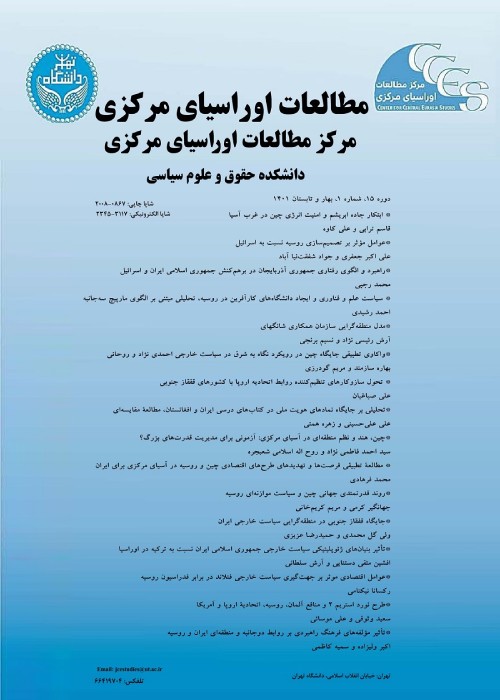Science and Technology Policy and the Establishment of Entrepreneurial Universities in Russia, an Analysis Based on the Triple Helix Model
There are significant historical similarities between Iran and Russia, so it is very useful to study Russia's experiences, especially to use it in policy-making process in Iran. Therefore, this article as a case study, focuses on the study of Russia's science and technology policy and the position of entrepreneurial universities in this country.Research Question: The main question of this research focuses on the Russia’s science and technology policies and its achievements, which are expressed in the following sub-questions: What are the developments of Russia’s science and technology policy in different periods of its history? How is the quality of science, technology and entrepreneurship in Russian companies and universities? What are the initiatives taken to build the institutional infrastructure for the development of cooperation between the main actors of science and technology in Russia? And finally, what lessons Russia’s experience have for formulating the science, technology, and entrepreneurship policies? Research Hypothesis: It seems that despite some efforts to establish an innovation system and design a systematic relationship between the triple institutions of science and technology in Russia, these institutions are divergent and therefore the system of innovation and entrepreneurship in this country does not work properly.
In order to promote research methodologically, the Triple Helix model was selected as the theoretical framework of the research. In the structure of this model, accordingly, the mutual and simultaneous relations of the triple variables (e g the Russian government, universities and companies) have been analyzed in the research process. From this point of view, the research considered as a “Structural Equation Modeling” which is an appropriate method to explaining the structural relationships between multiple variables in policy making and interdisciplinary studies. In terms of research method, this research follows the qualitative research method and the type of case study has been selected from different types of research studies.
the article consists of two main sections: in the first section, the history of science and technology is studied in three periods of Russian history: The Tsarist Russia, the Soviet Union and the Modern Russia. The second section is focused on the study of the interactions between the three institutions of science and technology in Russia, i.e. the government, companies and universities. In this context, the following topics have been studied: Government policy-making initiatives to strengthen the triple helix mechanisms; the attitude of Russian companies towards Research & Development and cooperation with universities and other outside scientific research centers; and Finally, the process of transition to entrepreneurial university in Russia has been studied in framework of the triple helix model. Research Findings show that in a historical perspective from the time of Tsarist Russia up to the present, the government as the main driver of innovation in this country, has failed to establish systematic cooperation between companies and Universities. Therefore, companies and scientific centers continue to operate under the government control. Historically, the evolution of science and technology policy in Russia has been influenced by the military requirements. Until the end of the nineteenth century, Russia’s main scientific institutes focused on basic research. During this period, there were no links between industry and scientific centers and universities. From the nineteenth century onwards, the government took some initiatives to solve the problem. However, these initiatives failed to establish a systematic interaction between the triple actors. Thus, a production system and a relatively strong research system continued to develop separately. During the past decade, the government has implemented new initiatives to develop systematic cooperation between the triple actors. So, Russia has taken some steps to create entrepreneurial universities which are the driving force of the triple helix system. Tomsk State University, which is the core of the electronic and informational technology innovation cluster in the region, is an example to the successful entrepreneurial universities in Russia.
However, the generation of entrepreneurial universities in Russia is still in its infancy and therefore has not yet entered the advanced stage of systematic cooperation between the three actors of innovation and entrepreneurship system. In the process of this transition, the triple helix system can be upgraded to a higher level of multiple helix system. Generally, in order to bridge Science and Technology, there are two major strategies to follow: first, changing basic institutions, stimulating market competition, and creating conditions for entrepreneurship and innovation; second, gradual improvement of current legislation, policies and practices. Regardless of which strategy to choose, it is important for the government to be consequential. This refers to the development, implementation and evaluation of science and technology policies and evidence-based decision-making. For example, during the last decade, some strategic policy documents to innovation has been approved in Russia, while the consistency among them are very low. The government’s announced support for innovative businesses faces common administrative barriers. These problems are also being targeted by the government through the ongoing administrative reform, but the improvements are still very modest. The results of Russia's initiatives to bridge science and technology have some policy-making lessons especially for Iran. Among them, the most important lesson is that supporting the entrepreneurial universities through creating regional entrepreneurship clusters with the centrality of selected universities can greatly contribute to transition of science.
- حق عضویت دریافتی صرف حمایت از نشریات عضو و نگهداری، تکمیل و توسعه مگیران میشود.
- پرداخت حق اشتراک و دانلود مقالات اجازه بازنشر آن در سایر رسانههای چاپی و دیجیتال را به کاربر نمیدهد.



